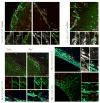Adult generation of glutamatergic olfactory bulb interneurons
- PMID: 19881504
- PMCID: PMC2787799
- DOI: 10.1038/nn.2416
Adult generation of glutamatergic olfactory bulb interneurons
Erratum in
- Nat Neurosci. 2010 May;13(5):649
Abstract
The adult mouse subependymal zone (SEZ) harbors neural stem cells that are thought to exclusively generate GABAergic interneurons of the olfactory bulb. We examined the adult generation of glutamatergic juxtaglomerular neurons, which had dendritic arborizations that projected into adjacent glomeruli, identifying them as short-axon cells. Fate mapping revealed that these originate from Neurog2- and Tbr2-expressing progenitors located in the dorsal region of the SEZ. Examination of the progenitors of these glutamatergic interneurons allowed us to determine the sequential expression of transcription factors in these cells that are thought to be hallmarks of glutamatergic neurogenesis in the developing cerebral cortex and adult hippocampus. Indeed, the molecular specification of these SEZ progenitors allowed for their recruitment into the cerebral cortex after a lesion was induced. Taken together, our data indicate that SEZ progenitors not only produce a population of adult-born glutamatergic juxtaglomerular neurons, but may also provide a previously unknown source of progenitors for endogenous repair.
Figures








Comment in
-
You are what you express: glutamatergic neurogenesis in the adult SVZ.Cell Cycle. 2010 Jun 15;9(12):2259-60. doi: 10.4161/cc.9.12.12018. Epub 2010 Jun 15. Cell Cycle. 2010. PMID: 20699635 No abstract available.
References
-
- Kokaia Z, Lindvall O. Neurogenesis after ischaemic brain insults. Curr Opin Neurobiol. 2003;13:127–32. - PubMed
-
- Ming GL, Song H. Adult neurogenesis in the mammalian central nervous system. Annu Rev Neurosci. 2005;28:223–50. - PubMed
-
- Gage FH. Mammalian neural stem cells. Science. 2000;287:1433–8. - PubMed
-
- Merkle FT, Mirzadeh Z, Alvarez-Buylla A. Mosaic organization of neural stem cells in the adult brain. Science. 2007;317:381–4. - PubMed
Publication types
MeSH terms
Substances
Grants and funding
LinkOut - more resources
Full Text Sources
Other Literature Sources
Molecular Biology Databases

